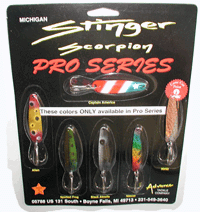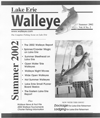|
The Eastern Lake Erie
Fishing Report
Summer 2003
By Joe Fischer
"In the past a cold long winter followed by a quick
warm-up led to an excellent spawning year for walleyes", stated Don Einhouse,
senior biologist at the Lake Erie Fisheries station in Dunkirk, New York.
The basis for this assumption is that the shoal walleyes will spawn later
and the quick warm up will hatch the eggs rapidly. The eggs then hopefully will avoid the early spring
windstorms in the eastern basin, which can easily decimate a class year of
open lake shoal spawning. Don Einhouse went on to cite historical data which
appears to back his theory. If this theory holds true this year could be one
of the best walleye spawning years in a long time. I sure hope he proves to
be right on this.
the eggs rapidly. The eggs then hopefully will avoid the early spring
windstorms in the eastern basin, which can easily decimate a class year of
open lake shoal spawning. Don Einhouse went on to cite historical data which
appears to back his theory. If this theory holds true this year could be one
of the best walleye spawning years in a long time. I sure hope he proves to
be right on this.
The early season shocking surveys on the Cattaraugus
Creek again showed a very healthy population of walleyes with over 60 fish
collected in less than an hour during one shocking stint. "Many of these
fish will undoubtedly will still be on the shoals and in the creeks when the
walleye season opens", remarked Bill Culligan, chief of fisheries at the
aforementioned Dunkirk station. Bill went on to say that this would probably
not be a problem as most females after spawning immediately leave the area
and go- to- open water where they become somewhat dormant as they recuperate
from the rigors of spawning. The vast majority of the walleyes caught in the
early season tend to be males because of the female's quick departure. The
Cattaraugus Creek incidentally, has become a success story for the New York
State Department of Environmental Conservation (NYSDEC). This Creek was used
in a NYSDEC sponsored 5-year walleye fingerling-stocking program that has
appeared to be an unqualified success. It also will be used as the benchmark
for another proposed walleye fingerling stocking program in the Buffalo
River_ a large urban river located within the city limits of Buffalo. Bill
Culligan also remarked that the fall netting surveys of 2002 revealed a
substantial healthy 2001 class year of walleyes, which are now approximately
legal size at IS".
"The lake wide class years of 2000 and 2002 produced very
poor walleye recruitment especial1y in the western 'basin, these poor
spawning years wi11 have a very negative effect on the walleye fishery for
the coming years", Remarked Don Einhouse. Don went on to say that there was
a good possibility that the commercial quotas for walleye wilt be reduced in
the future to reflect the reduced walleye population. The eastern basin
however, appeared to have better walleye survival rates during these Poor
years so the walleye fishing will probably be quite stable.
The early season started slowly with very few walleyes
caught by the near shore night fishermen. This was not totally unexpected
with the water temperatures hovering around45F. This changed rapidly near
the end on May with rising water temperatures activating the many male
walleyes still occupying the shallow water near Buffalo and the shoals in
the Dunkirk Barcelona area. Some limit catches were reported and a lot of
fish were caught in late May and early June. It is hard to get a handle on
this fishery as many night-time fishermen tend to be tight lipped and not
many people are around when these fishermen leave the water sometimes as
late as 4:00AM! I generally gauge the fishing success by the amount of boats
still present on the water after 1:00AM, if there is still a lot of boats on
the water generally fish are being caught!
In the risk of being redundant the standard method
employed by most night fishermen is long line trolling in 5 to 10 feet of
water over Lake Erie shoals using stick baits such as the No. 13 floating
Rapala and Junior Thunderstick. Preferred colors are black and silver,
Chartreuse, Firetiger and Blue and silver. If you run one for a period of
time with no results change colors or lures. These fish are easily spooked
in the shallow water so it is important to be as possible and
keep the lighting to a minimum when netting a fish. This early season
walleye fishery is strictly for the hardy as nighttime temperatures in May
can get down to the low 40's and it can be very cold especially if there is
a little wind. The positive side of this type of fishing is that it is
quiet, generally calm, and the 2-41b male walleyes caught in the cold early
season water are some of the best eating I have ever experienced.
The late cold winter played a major role in the mid spring and early
summer (June, early July) walleye fishing with the cold water temperatures
keeping the post spawn fish rather dormant and scattered throughout the
eastern basin. This led to many long fruitless trolling stints in search of
feeding walleye. There was no consistent depth or area where the fish were
caught so a lot of time and distance had to be covered to catch a few
"eyes". At the present time the summer weather is elevating the water
temperature rapidly and the walleye fishing should pick up quickly as
mid-summer approaches. I will have more on this in the next issue plus the
results of the annual Southtowns walleye tournament which last year produced
a record 200 plus fish over 10 pounds. Southtowns website is at
http://hometown.aol.comltrm1O52/swa.html.
"We had the best perch fishing in many years", said veteran hardwater
angler Herb Schultz. Herb echoed the sentiments of many ice fishermen who
were pleasantly surprised by the return of the great perch fishing
experienced in past years. This excellent perch fishing carried on into the
spring and early summer with many veteran Lake Erie fishermen recording
limit or near limit catches of 8-12" perch. As stated in earlier articles,
look for the small clusters of boats between Sturgeon Point and the
Cattaraugus Creek and using good emerald shiners is the key to getting
started if you want to take advantage of this excellent perch fishery. In my
opinion the only fish that is better eating than a walleye is a perch!
Smallmouth bass fishing seems to be increasing in popularity with more
and more fishermen taking advantage of this world class fishery. Last year
for the first time more trips on Eastern Lake Erie were made with smallmouth
bass as the target fish than walleye.
If you desire more information on eastern Lake Erie call the Talking
Phone Book Fishing Information Hot Line at 716-844-1111 ext.4142. Fishing
information can also be obtained at www.northeastoutdoors.com or
www.niagara-usa.com. An excellent new free fishing "Hot Spot" map is
also available This map can be obtained by calling the Erie County Dept. of
Environment and Planning at 866-345-FISH. The Erie County and Niagara County
Fish Advisory boards used their vast local fishing knowledge in the assembly
of these excellent maps.
|





 the eggs rapidly. The eggs then hopefully will avoid the early spring
windstorms in the eastern basin, which can easily decimate a class year of
open lake shoal spawning. Don Einhouse went on to cite historical data which
appears to back his theory. If this theory holds true this year could be one
of the best walleye spawning years in a long time. I sure hope he proves to
be right on this.
the eggs rapidly. The eggs then hopefully will avoid the early spring
windstorms in the eastern basin, which can easily decimate a class year of
open lake shoal spawning. Don Einhouse went on to cite historical data which
appears to back his theory. If this theory holds true this year could be one
of the best walleye spawning years in a long time. I sure hope he proves to
be right on this.